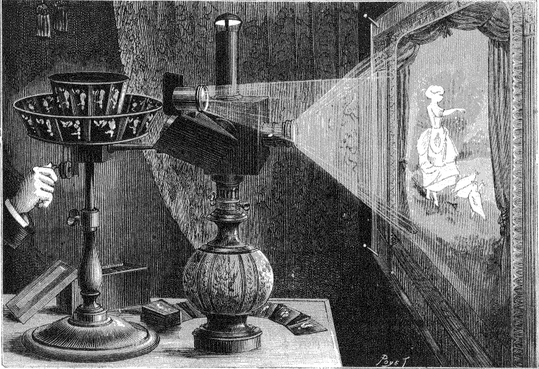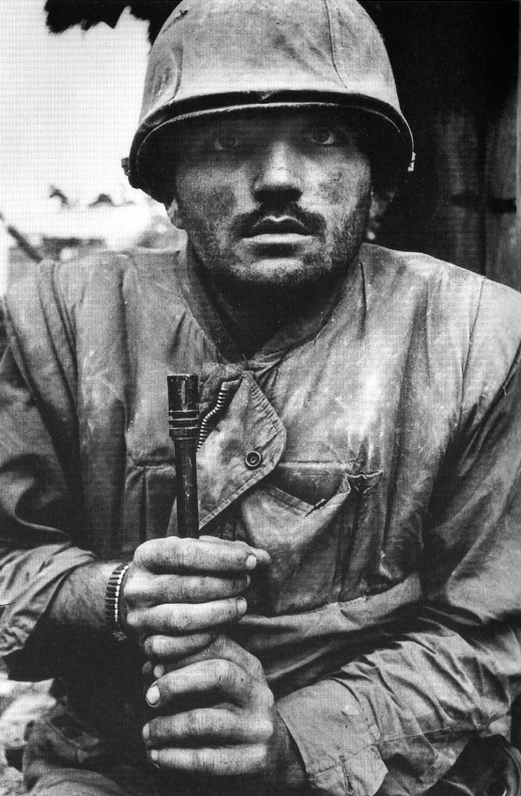- Animation is derived from the Latin word 'Animare' meaning 'To give life to'.
- Animation involves artificially creating a series of images that give the illusion of movement. When played back fast enough, the series of images fool the brain into thinking that movement is taking place, aka 'Persistence of Vision'.
History of Animation
- Humans have illustrated stories sequentially for thousands of years on walls, bowls, vases etc
Egyptian burial chamber mural - approx. 4000 years old.
The Magic Lantern
- This was a box with a parabolic mirror at the back which focussed light through a hand drawn slide, then through a lens that could be adjusted.
- The lantern was not very efficient as the only light sources were candles and oil lamps.
The Thaumatrope (1824)
Credited to John Herschel, but made popular as a toy by John Paris
- Simple spinning disc that, when spun fast enough, made it seem as though both images were there.
The Phenakistoscope (1831)
- It was invented simultaneously by the Belgian Joseph Plateau and the Austrian Simon von Stampfer.
- It consists of a disk with a series of images drawn on a radii, evenly spaced around the centre. Slots are cut out of the disk on the same radii as the drawings, but at a different distance from the centre. The device would then be placed in front of a mirror and spun.
- As the Phenakistoscope spun, a viewer would look through the slots at the reflection of the drawings which would become visible when a slot passes by the viewer's eye.
The Zoetrope (1834)
- The Zoetrope produces the illusion of motion from a rapid succession of static images. As it has multiple slits that can be viewed through, it was much more practical than the Phenakistoscope.
The Kineograph/Flipbook (1868)
- Pierre-Hubert Desvignes is usually credited with inventing the Kineograph.
- John Barnes Linnett of London was the first to patent a design.
Praxinoscope projection
Praxinoscope projector - Charles-Émile Reynaud
- Reynaud's projections predate Edison's Kinetoscope and the Lumiere Brothers Cinematograph.
'Animation is not the art of drawings that move, but the art of movements that are drawn.' Norman McLaren 1914 - 1987
'In order to move forward you need to know where you have come from.' Michaela Pavlatova 2013
Animation: 1900 - 1927
- A combination of live action and stop motion animation. Makes use of various techniques to allow us to explore the moon.
- This iconic film has been referenced numerous times by artists, musicians and comedians, such as The Mighty Boosh, Queen, The Smashing Pumpkins and many more...
Émile Cohl: Fantasmagorie (1908)
- Drawn in pencil and then photographed onto negative film (which gives it its chalkboard look) Fantasmagorie is regarded as one of the first 'modern' animations.
- The oldest surviving feature length animation. It achieved critical success when it was released.
- Silhouette animation with backgrounds and hand tinted frames to colour.
- The story is based upon One Thousand and One Nights (Arabian folktales).
Animation: 1928 - 1957 The Golden Age of Cartoons
- By 1928, animation had developed enough of a language, both technical, artistically and importantly commercially.
- This meant that they were no longer regarded as just 'high art' but also commercially viable, profitable and extremely popular.
- Cartoons had become mainstream.
- People like the Fleischer Brothers, Reynaud, Starewicz and Reiniger had paved the way and produced films that could entertain and be funny.
- Then came the emergence of Walt Disney
- Disney Studios first animation.
- First animation to have a fully post-produced and synchronised soundtrack. (Fleischer's Inkwell studios had tried but they always went out of synch)
- Skeleton Dance from Disney's 'Silly Symphonies'
- The animation was developed to fit around composer Carl Stalling's work, rather than the other way around. Was this the first music video?
- First time we are introduced to Betty Boop
- Popeye was actually part of the Betty Boop series, but became so popular he got his own series.
- This is an example of 'Direct Animation' where the actual film stock has been manipulated.
- It's regarded as one of the most significant animation films of all time.
- It inspired other great animators such as Norman McLaren.
- This is commercial work to sell the idea of a fast, speedy parcel service.
Disney, WW2 and Propaganda (1943-5)
Disney produced a number of films during this time to support the war effort of the American government. Including:
- Disney: Education for Death: the Raising of a Nazi
- Disney: Victory Through Air Power (1943)
- UPA Films: The Brotherhood of Man (1945)
- An adaptation of a Dr Seuss story about a boy who can only produce sounds not words.
- The animation has a great minimalist look and feel, but the characters are full of charm, and wonderfully drawn and animated.
- Regarded as a Chuck Jones Classic.
- Breaks the boundaries of the cartoon and has Daffy Duck arguing with the animator.
- Highly stylised graphic title sequences.
- Also worked on Anatomy of a Murderer and Vertigo.
The end of The Golden Age of Animation
- In the late 50s/early 60s, the practice of having Block booking animated shorts with a feature film came to an end.
- Rise in popularity of television meant that broadcasters demanded large quantities of programming on low budgets.
- Backgrounds were simplified, animation walk cycles and lip-synching were reused, resulting in the slow decline of 'quality' feature animations.
- These were replaced by much cheaper, mass produced shorts by companies such as Hanna-Barbera.
The Television Age (1958 - 1985)
Hanna-Barbera (1960 onwards) Flinstones, Huckleberry Hound
Ray Harryhausen: Jason and the Argonauts (1963)
Osamu Tezuka: Astro Boy (1963)
Chuck Jones: The Dot and the Line: A Romance in Lower Mathematics (1965)
1966 - Walt Disney dies
Terry Gilliam: Monty Python's Flying Circus (1966)
Ivor Caprino: The Pinchcliffe Grand Prix (1975)
Tim Burton: Vincent (1982)
Steven Lisberger: Tron (1982)
Moving towards the Digital Age (1985 onwards)
- John Lasseter co founded Pixar with Steve Jobs in 1986
- This short showed the potential that 3D Computer Animation had and was regarded as groundbreaking at the time.
Brothers Quay: Street of Crocodiles (1986)
Jan Svankmajer: Alice (1988)
Disney: Who Framed Roger Rabbit (1988)
Disney: Beauty and the Beast (1991)
- First used 3D animation to produce background in ballroom scene
Steven Spielberg: Jurassic Park (1993)
John Lasseter: Toy Story (1995)
Mamoru Oshii: Ghost in the Shell (1995)
Jamie Hewlett: Gorillaz - Clint Eastwood (2001)
Henry Selick: Coraline (2009)















































